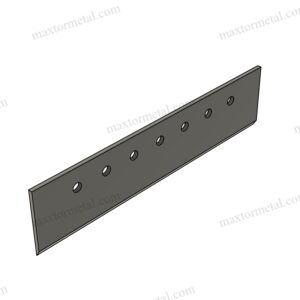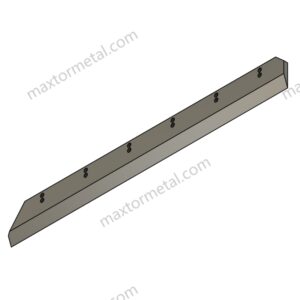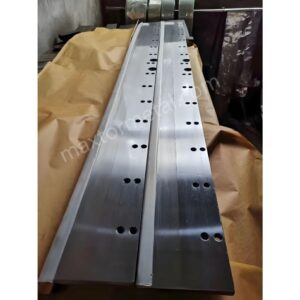| Autres Noms | lames de guillotine, coupe-guillotine, couteau à guillotine, lames industrielles pour papier, couteaux de conversion de papier, lames de coupe de papier, matériaux de couteau de coupe de papier, lames de coupe de papier |
|---|---|
| Lieu d'Origine | Chine |
| Application | Plastique, Papier, Carton, Non-tissé, Film, Feuille, Étiquettes, Ruban adhésif, Textile, Emballage, Tapis, Sacs, Caoutchouc |
| Matériau | 65Mn,9CrSi,Cr12MoV,SKD-11,HSSl |
| Numéro de Modèle | CV-RS |
| Service OEM | Disponible |
| Conditions de Paiement | L/C, T/T, Western Union |
| Emballage | Boîte en Carton, Caisses en Bois |
| Délai de Livraison | 7-20 Jours |
Partager sur :
Les couteaux à papier industriels, également appelés lames de coupe ou lames de guillotine dans certains contextes, sont des outils de coupe robustes et de précision conçus pour les machines de découpe de papier industrielles. Ces couteaux sont conçus pour couper efficacement et avec précision de grandes piles ou des bandes continues de papier et de carton dans des environnements de production à grande échelle. Le terme « couteaux à papier industriels » souligne leur robustesse et leur aptitude à un fonctionnement continu et exigeant dans les processus de fabrication et de transformation des industries du papier, de l'impression et de l'emballage.
Couteaux Industriels pour Coupe de Papier Les presses à papier sont des outils essentiels à différentes étapes du traitement et de la transformation du papier. Leurs principales applications comprennent :
La sélection du matériel pour Couteaux Industriels pour Coupe de Papier est crucial pour obtenir des performances de coupe, une longévité et une résistance à l'usure optimales, notamment avec différents types de papier, notamment abrasifs et couchés. Les matériaux les plus courants sont :
Des revêtements tels que le nitrure de titane (TiN) ou le chrome peuvent être appliqués pour améliorer la dureté de la surface, réduire la friction et améliorer la résistance à la corrosion, prolongeant ainsi encore la durée de vie de Couteaux Industriels pour Coupe de Papier.
Couteaux Industriels pour Coupe de Papier Ils se présentent sous diverses formes et configurations, adaptées à des procédés de découpe et des machines spécifiques. Les formes les plus courantes sont :
La géométrie du couteau de découpe industriel, notamment l'angle, le biseau et le tranchant de la lame, est essentielle pour obtenir des coupes nettes et précises et maximiser la durée de vie de la lame. Le choix de la forme et du matériau de la lame dépend du type de papier à découper, du procédé de découpe et des exigences de volume de production.






Profitez de la commodité d'une importation fluide. Du transport au dédouanement, nous gérons l'ensemble du processus. Il vous suffit de payer la TVA et d'attendre l'arrivée de vos marchandises.
Nous avons vu nos lames exceller dans d'innombrables applications et sommes prêts pour tout projet que vous nous confierez. Attendez-vous à la précision, à la durabilité et à des prix compétitifs inégalés.
Que vous fournissiez des dessins, des croquis ou des échantillons, nous pouvons concevoir et fabriquer pour vous. Nous avons également la capacité d'aider à modifier les conceptions et spécifications existantes pour améliorer presque toutes les applications d'outillage industriel. Veuillez contacter notre équipe de vente dédiée pour discuter de vos besoins spécifiques.
Une série de tests et d'inspections sont effectués pour contrôler la qualité, incluant l'inspection du premier article, l'inspection des matériaux entrants et les matériaux certifiés, l'inspection qualité en cours de production, et l'inspection qualité finale.
Que vous soyez un importateur, un distributeur, un grossiste ou un utilisateur final, nous vous accueillons. Bénéficiez de faibles quantités minimales de commande (MOQ), de demandes sans tracas et d'une plus grande liberté d'achat.
Considérez-nous comme votre moniteur exclusif. Nous vous fournirons régulièrement des mises à jour sur chaque étape cruciale de votre chaîne de production. Quelle que soit la distance, vous aurez un aperçu en temps réel de l'avancement de votre produit.
Le guide ultime pour l'entretien des lames de coupe à guillotine : prolonger la durée de vie et optimiser les performances
Nanjing Metal Industrial CO., Limited
Mingjue Industrial Park, Lishui, Nanjing, Jiangsu, China
Restez informé de nos dernières actualités.